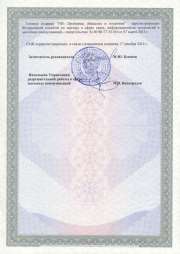|
MAIN PAGE
> Back to contents
National Security
Reference:
Starkin S.V.
Autonomous development of the national military-industrial complex in the conditions of globalization: the analysis of the problem
// National Security.
2015. є 1.
P. 88-100.
DOI: 10.7256/2454-0668.2015.1.14437 URL: https://en.nbpublish.com/library_read_article.php?id=14437
јвтономное развитие национального военно-промышленного комплекса в услови€х глобализации: анализ проблемы
Starkin Sergey Valer'evich
Doctor of Politics
Professor, the department of Political Science, Institute of International Relations and World History of Lobachevsky State University of Nizhny Novgorod; Leading Scientific Associate, International Interdisciplinary Laboratory "Study of Global and Regional Socio-Political Processes", N. A. Dobrolyubov State Linguistic University of Nizhny Novgorod
603000, Russia, g. Nizhnii Novgorod, ul. Ul'yanova, 1, kab. 307

|
starkinserge@mail.ru
|
|
 |
Other publications by this author
|
|
|
DOI: 10.7256/2454-0668.2015.1.14437
Received:
11-02-2015
Published:
08-03-2015
Abstract:
This paper analyzes the approaches of a number of countries towards maintaining their military-industrial base that is capable of supporting their national security, as well as a range of maneuvers available to them within the political continuum in the context of globalization. Available empirical evidence shows that globalization has transformed the structure of incentives for small and medium-sized countries. Despite the fact that the countries such as Sweden, South Africa, and Israel have a high level of defense-industrial autonomy, and were forced to make significant reforms in order to preserve the military-industrial complexes in the context of globalization. Considering Russia's initiatives in building the Customs Union and the Eurasian Economic Union, the issues of integration, the specialization and distribution of labor between the two countries, especially in the sphere of military-industrial industry, seem particularly relevant. The author concludes that small countries can restructure their defense agencies to increase their contribution into national security and successfully compete in the global arms market. It is obvious that the government has a number of options to achieve this goal, including various combinations of exports and foreign direct investments. Alternative ways to support countries own defense industry suggests that the military-industrial globalization, in terms of the international system will not lead to the disappearance of the national defense industry, and will not strengthen the larger nations at the expense of smaller ones. Competent and patriotically-minded leaders have all the conditions and institutional mechanisms to be able to raise the level of the national security system in their countries, while maintaining strategic internal capabilities and increasing export of defense components and systems.
Keywords:
technology transfer, military-industrial complex, military-technical cooperation, defense markets, armaments, national security, defense industrial policy, globalization, regional security, international security
References
1. Devore Marc R. Arms Production in the Global Village: Options for Adapting to Defense-Industrial Globalization // Security Studies. Ц 2013. Ц є 22:3. Ц R. 532-572.
2. Coulomb F. Adam Smith: A Defense Economist // Defense and Peace Economics. Ц 1998. Ц є 9:3. Ц R. 299Ц316.
3. Trebilcock C. ЂSpin-Offї in British Economic History: Armaments and Industry, 1760Ц1914 // The Economic History Review. Ц 1969. Ц є 22:3. Ц R. 474Ц490.
4. Benoit E. Growth and Defense in Developing Countries // Economic Development and Cultural Change. Ц 1978. Ц є 26:2. Ц R. 271Ц287.
5. Ross A. Arms Production in Developing Countries: The Continuing Proliferation of Conventional Weapons. Santa Monica,CA: RAND, Ц 1981. Ц 287 r.
6. Katz J. Understanding Arms Production in Developing Countries / Arms Production in Developing Countries, ed. James Katz. Lexington, MA: D.C. Heath, Ц 1984. Ц 315 r.
7. Starkin S.V. O transformatsii oboronnoi promyshlennosti SShA // Vestnik Nizhegorodskogo universiteta im. N.I. Lobachevskogo. Ц 2007. Ц є 6. Ц S. 231-237.
8. Keller W. Global Defense Business: A Policy Context for the 1990s / Global Arms Production: Policy Dilemmas for the 1990s, ed. Ethan Kapstein. Lanham, MD: University Press of America, Ц 1992. Ц 149 p.
9. Anthony I. The СThird TierТ Countries / Arms Industry Limited, ed. Herbert Wulf. Oxford: Oxford University Press, Ц 1993. Ц 524 p.
10. Klare M. The Unnoticed Arms Trade: Exports of Conventional Arms-Making Technology // International Security. Ц 1983. Ц є 8:2. Ц R. 68Ц90.
11. Bitzinger R. Towards a Brave New Arms Industry? Oxford: Oxford University Press, Ц 2003. Ц 217 p.
12. Markusen A., Costigan S. The Military Industrial Challenge / Arming the Future: A Defense Industry for the 21st Century. ed. Ann Markusen and Sean Costigan. New York: Council of Foreign Relations, Ц 1999. Ц 315 p.
13. SIPRI Military Expenditure Database 2011. URL: http://milexdata.sipri.org (data obrashcheniya 12.12.2013).
14. Ziegler J. Semiconductors / Defense & Dependence in a Global Economy, ed. Raymond Vernon and Ethan Kapstein. Washington,DC: Congressional Quarterly Press, Ц 1992. Ц 197 p.
15. Dowdall Paul. Chains, Networks and Shifting Paradigms: The UK Defence Industry Supply System // Defense and Peace Economics. Ц 2004. Ц є 15:6. Ц R. 535Ц50.
16. Dunne J.P., Macdonald G. Procurement in the Post-Cold War World: A Case Study of the UK / The Restructuring of the European Defense Industry. ed. Claude Serfarti. Brussels: European Commission, Ц 2001. Ц 265 p.
17. Brooks S. Producing Security: Multinational Corporations, Globalization, and the Changing Calculus of Conflict. Princeton, NJ: Princeton University Press, Ц 2005. Ц 274 p.
18. Finnegan P. The Evolution of International Defense Hierarchies / The Modern Defense Industry, ed. Richard Bitzinger. Santa Barbara, CA: ABC CLIO, Ц 2009. Ц 197 p.
19. Struys W. The Future of the Defense Firm in Small and Medium Countries // Defence and Peace Economics. Ц 2004. Ц є 15:6. Ц R. 551Ц564.
20. Stairs D. Conclusion / Security, Strategy and the Global Economics of Defence Production. ed. David Haglund and Neil MacFarlane. Montreal: McGill University Press, Ц 1999. Ц 285 p.
21. Krause K. Arms and the state: patterns of military production and trade. Cambridge, Ц 1992. Ц 265 p.
22. Moran T. The Globalization of AmericaТs Defense Industries: Managing the Threat of Foreign Dependence // International Security. Ц 1990. Ц є 15:1. Ц R. 57Ц99.
23. Ursul A.D. Natsional'naya ideya i global'nye protsessy: bezopasnost', ustoichivoe razvitie, noosferogenez // Voprosy bezopasnosti.-2013.-2.-C. 1-66. DOI: 10.7256/2409-7543.2013.2.541. URL: http://www.e-notabene.ru/nb/article_541.html
24. Ursul A.D. Problemy bezopasnosti i ustoichivogo razvitiya: evolyutsionnyi podkhod i mezhdistsiplinarnye perspektivy // Voprosy bezopasnosti.-2014.-5.-C. 1-62. DOI: 10.7256/2409-7543.2014.5.14221. URL: http://www.e-notabene.ru/nb/article_14221.html
25. Skrynchenko B.L., Moroz V.D., Gribakina N.A. Voenno-ekonomicheskii analiz, ego vidy i osnovnye etapy // Natsional'naya bezopasnost' / nota bene.-2014.-4.-C. 553-559. DOI: 10.7256/2073-8560.2014.4.12653.
Link to this article
You can simply select and copy link from below text field.
|
|





